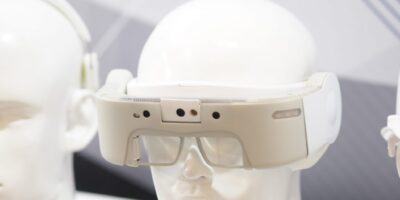Keeping an eye of trends at Computex 2017
Earlier this month, Computex 2017, welcomed over 41,000 visitors from 167 countries. The show continues to grow and the organiser, the Taiwan External Trade Development Council (TAITRA) has implemented new areas to track technology trends to reflect the changes in the industry. Wearable technology was represented, reports Caroline Hayes.
This year, Computex hosted the SmarTEX area in Exhibition Hall 1, of the Taipei World Trade Center. The collection of exhibitors focused on the IoT ecosystem, with over 120 companies showcasing technologies for IoT, home security, smart home and entertainment, internet of vehicles and automotive electronics as well as wearable technology.
Of these, a partnership of Jorjin Technologies, InfinityAR and Lumus, who collaborated to create J-Reality, believed to be the first Android mixed reality (MR) smart glasses. The glasses do not require a connection to a PC or phone.
Jorjin Technologies provides modular processing, inertiaI measurement unit (IMU), sensing, and wireless connectivity, coupled with InfinityAR’s augmented reality development engine, combined with augmented reality (AR) transparent displays from Lumus.
The J-Reality glasses blend holograms with MR, using a proprietary positional tracking technology, and hand gesture control. The glasses also include a front-facing, high resolution camera, with built-in microphones and speakers.
The positional tracking and scene understanding technology is powered by Israeli company, InfinityAR’s Inside-Out Simultaneous Localization and Mapping (SLAM) technology powers the positional tracking and scene comprehension capability, for accurate augmented reality experiences, while Lumus provides the optical technology to enable a bright immersive and daylight-readable AR. The Lumus Optical engine contributes to the small form factor, combining a patented Light Guide Optical Element (LOE), a reflective waveguide, and a microdisplay pod to create the virtual image of a transparent, colour, projection over the user’s surroundings. The engine provides an immersive 40 degree field of view for the glasses, while the SLAM architecture is low computation, low power, for mobile use, and contributes to the light weight and affordability of the MR headsets, says Jorjin.
Jorjin began to design and manufacturer processor, sensor and wireless connectivity modules in 1997, and created a team dedicated to smart glasses original design manufacturer (ODM) in 2013. Its expertise in system in packaging (SiP) design and integration are used to create lightweight, small products, priced for the consumer market. A new imaging team has been charged to design a range of camera sensor modules, 3D time of flight (ToF) cameras and other sensors to develop smart glasses for various industries applications.
WEARTECHDESIGN.COM – Latest News/Advice on Technology for Wearable Devices
Weartechdesign is unlike any other website currently serving the technology
for wearable devices. We carry the very latest news for design engineers and purchasers.
Register on our mailing list to receive regular updates and offers from
WearTechDesign




